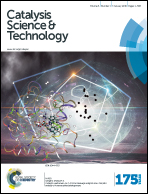In situ fabrication of AgI/AgVO3 nanoribbon composites with enhanced visible photocatalytic activity for redox reactions†
Abstract
AgI/AgVO3 nanocomposites have been newly synthesized through a facile in situ ion-exchange approach with β-AgVO3 nanoribbons as the Ag source and support to immobilize AgI. The as-prepared composites can serve as highly efficient visible light-driven photocatalysts toward selective oxidation of benzylic amine to imine and reduction of toxic Cr(VI) ions. It is found that the mole ratios of AgI have an essential effect on the photocatalytic redox activity and the highest photocatalytic performance is obtained over the 20% AgI/AgVO3 nanocomposite. AgI in situ grown on the surface of β-AgVO3 nanoribbons facilitates close interfacial contact, which thus improves the separation of photoinduced electron–hole pairs. On the basis of detailed characterization of a typical 20% AgI/AgVO3 sample before and after photocatalytic reactions, Ag0 species is formed in the initial stage of the reactions. The considerable improvement in the photocatalytic redox properties of AgI/AgVO3 is mainly ascribed to the efficient separation of photoinduced electrons/holes via a Z-scheme bridge mechanism of formed Ag/AgI/AgVO3, in which Ag nanoparticles serve as the charge migration bridge.


 Please wait while we load your content...
Please wait while we load your content...